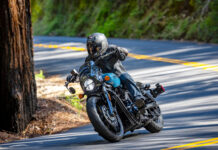photography by the author, James Norris, Roger Eggers and Kail Wathne
[Rider’s 250-class Dual-Sport Motorcycle Comparison including the 2008 HONDA CRF230L, 2009 KAWASAKI KLX250S and 2009 YAMAHA XT250 was originally published in the October 2008 issue of Rider magazine]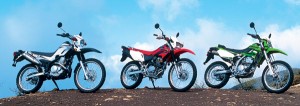
“Let’s get small.” With gas nudging five bucks a gallon, the tag line from comedian Steve Martin’s 1970s routine is looking like pretty good advice.
While downsizing is usually an unpopular habit of CEOs, when it refers to riding a smaller, economical motorcycle for commuting and weekend play, the results can be delightful. Light, nimble quarter-liter dual-sports are frisky enough to zip through weekday traffic, then kick up dust all weekend and won’t induce showroom sticker shock or max out your credit card at the gas pump. In reviewing Kawasaki’s 2006 KLX250S (see Rider, June 2006), we suggested it could spark a renaissance of the 250 dual-sport class; two years later, riding a new wave of dual-sport popularity, there are three 250 multitaskers available for less than $5,000–the 2008 Honda CRF230L, Yamaha’s 2009 XT250, and the revamped 2009 Kawasaki KLX250S. If you ever needed an excuse to add a playbike to your stable, this is it. And before you dismiss a 250 as too small, consider that the thirstiest bike here averaged nearly 60 mpg when ridden hard and put away dusty√âafter a heck of a fun day.
As you’d expect, our threesome shares some basic design features like semi-double-cradle steel frames, high exhausts equipped with USDA-approved spark arrestors, and 18- and 21-inch rims shod with dual-sport tires. Disc brakes stop both wheels, single-shock rear suspensions control the back ends, electronic ignitions manage the spark, and they all start at the touch of a button. Beyond that, each manufacturer has leveraged or improved existing models to build their interpretation of today’s 250 dual-sport.
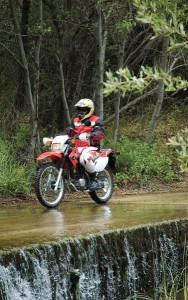
Honda and Yamaha worked the light-and-simple angle, Honda building a street-legal version of its CRF230F offroad machine and Yamaha beefing up its XT225 dual-sport. Both use air-cooled, SOHC two-valve motors, a 223cc unit with a 9.0:1 compression ratio in the Honda and a 249cc mill that squeezes combustibles at 9.5:1 in the Yamaha. The Honda sips fuel through a frugal 30mm constant-velocity carb, while the Yamaha gets a larger gulp through its 33mm CV mixer. Raising the bar on complexity and power output, Team Green outguns both with a liquid-cooled, DOHC, four-valve 249cc mill, 34mm CV carburetor and 11.0:1 compression ratio, setting the stage for Kawasaki one-upmanship throughout the test. It also has the highest MSRP at $4,899. The Honda retails for $4,499 and the Yamaha (now a 2009 model, but unchanged from the 2008 we tested) is $4,549.
Power differences were evident from the get-go, with the Kawasaki out front. The other test riders–two guys I’ve ridden dual-sports with for decades, and one who’s new to the dirt–all thought the Yamaha edged out the Honda in power, and there was no question that its wide-ratio, five-speed gearbox made it easier to ride in town. The Honda’s first of six gears is too low for quick departures from a stoplight and second is a touch too high, while the Yamaha’s higher gearing and power advantage make fast starts a snap. The KLX, with more punch, six well-spaced gears and a 10,500-rpm redline (it’s the only one with a tach), takes the honors in the boulevard battle. When the road kinks up and the focus is fun, they all require revs and cornering speed to maintain momentum–tap the brakes or back off a bit, and you’re suddenly looking at taillights. The KLX and XT spin up nicely from midrange, but the CRF can hesitate when you open the throttle after backing off, even with the motor in its sweet spot. It’s also the buzziest of the bunch, annoyingly so at times, at any throttle setting.
Outwardly, the brake systems look almost interchangeable, with front/rear rotor sizes of 240/203mm for the Yamaha, 245/220mm on the Honda, and 250/240mm on the Kawasaki, all grabbed by twin-piston calipers up front and single-pot units out back. On the road, we found big differences. One tester described the Honda’s front brake as “digital,” either on or off, while everyone praised the Kawasaki as having the strongest and most progressive binders. The Yamaha stopped nearly as well as the Honda, with better control but less power from the front brake and noticeably more fork dive.
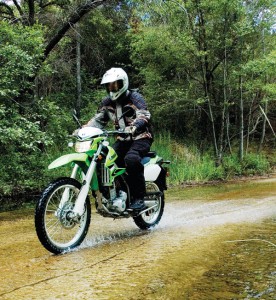
From driveway to byway, our photo ride was a classic dual-sport Sunday. After a coffee stop we filtered through town, then up a tight, steep mountain road of patched and potholed pavement, across a serpentine ridge on smooth tarmac and down the back side on a pebbly, rutted dirt road that continued for many miles into the backcountry.
Like all dual-sports, this group was right at home on lumpy, serpentine asphalt, and that’s where suspension differences became evident. The Kawi KLX’s stout 43mm male-slider fork provides 10 inches of travel, compression damping adjustment, and a firm but compliant ride that’s matched by the Uni-Trak rear setup with adjustable rebound and compression damping and 9.1 inches of travel. Potholes mean nothing to this bike. Yamaha used the 35mm fork from the XT225, giving it slightly stiffer springs for 8.9 inches of travel, while the swingarm moves 7.1 inches via a Monocross-style linkage. The Honda XT250 had the softest suspension in the test. The Honda’s 37mm standard fork has 9 inches of travel, with 6.3 at the rear; though both ends are firmer than the XT, you’ll still want to avoid the deeper potholes. It’s no surprise that the Kawasaki is stable in the corners, but the Honda grabs the inside line and keeps it, thanks to a wheelbase 3.5 inches shorter than the Kawi’s. The CRF transmits small bumps to the rider harder than you might like, but stays on track through the tightest, quickest turns. The Yamaha prefers smoother surfaces and flexes when pushed hard, but the flickable, compact XT also carves a tight line around hairpins.
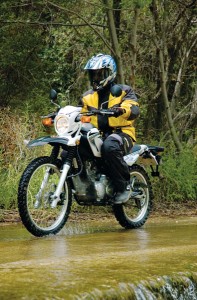
When the pavement peters out, the Honda and Yamaha can both be ridden quickly over suspect terrain. It’s the bigger bumps and washboard straightaways that let the Kawi’s handling and power shine through. The XT and CRF go head-to-head on dirt roads, the power advantage going to the XT, and the handling honors to the CRF. At trials-rider speeds, the Honda’s low first gear is a plus. All of the bikes are comfortable in a Dakar-style standing position and comport themselves well when steered by the pegs. When seated, the Honda and Yamaha–with seat heights of 31.9 inches, 3 inches lower than the Kawasaki–are low enough to build confidence in new riders, but experienced pilots preferred the taller KLX. With a nod to long rides off the pavement, Kawasaki fitted a dirt-ready oiled-foam air filter, while the Honda sports a modular paper element/anti-backfire screen combo and the Yamaha gets by with a tiny paper element. Only the KLX provides any protection for its aluminum cases, a small glide plate and case/water pump guards welded to the frame. One guard on our test bike had already been whacked hard enough to crack the weld.
When Monday arrives and the multitaskers switch to city life, where getting small means getting around, it’s harder to pick a favorite. The Yamaha’s tight turning radius and gentle manners give it an edge in cutting through gridlock, but the taller KLX provides a better view and commands a bit more respect. It’s also the only one here with the moxie for more than a couple exits worth of freeway travel. The mileage prize goes to the Honda, returning a frugal 73.1 mpg, while the XT takes second place with 64.0 mpg to the KLX’s 59.9. The order is the same when you look at computed range: 168.1 miles on a full Honda tank, 166.4 (153.6 in California) for the Yamaha, and just 119.8 for the Kawasaki.
Any bike in our quarter-liter quiver will get you to work, school, or into the boonies and back again without complaint. And any of them will take a bite out of your fuel bill. The best bike is the one that satisfies your budget, expectations and riding style. The Honda and Yamaha are simple motorcycles better suited for less experienced riders or those who ride at a more relaxed pace. The Yamaha’s free-revving motor is a gem, and it’s the easiest to ride, but its suspension can limit spirited riding. The CRF is the least expensive
to buy and operate, but suffers from awkward tranny ratios, uneven carburetion and vibration. My pick is the KLX because it suits my riding style and preferences and will entertain me on the way to work or anywhere else I choose to ride it, but its height and dirt bias won’t appeal to everyone. It’s also the heaviest, carries the least gas and costs the most, things I can overlook for its performance advantage. If I couldn’t afford the KLX, I’d have to flip a coin√âor save a few more coins until I could afford it. In any case, if you downsize with one of these machines, you might find yourself living it up!
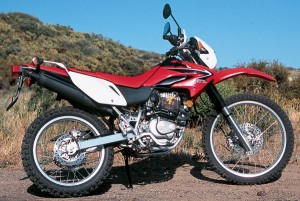
2008 Honda CRF230L
Base price: $4,499
Engine Type: Air-cooled single, SOHC, 2 valves per cyl.
Bore x Stroke: 65.5 x 66.2mm
Displacement: 223cc
Transmission: 6-speed, cable-actuated wet clutch
Final drive: #520 O-ring chain
Wheelbase: 52.75 in.
Rake/Trail: 26.83 degrees/4.0 inches
Seat Height: 31.9 in.
Wet Weight: 271 lbs. (includes accessory rack and hand guards)
Fuel Capacity: 2.3 gals. incl. 0.7-gal. res.
Average mpg: 73.1
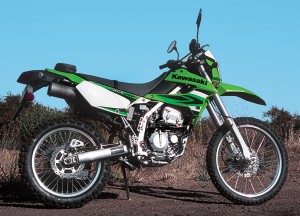
2009 Kawasaki KLX250S
Base price: $4,499
Engine Type: Air-cooled single, SOHC, 2 valves per cyl.
Bore x Stroke: 65.5 x 66.2mm
Displacement: 223cc
Transmission: 6-speed, cable-actuated wet clutch
Final drive: #520 O-ring chain
Wheelbase: 52.75 in.
Rake/Trail: 26.83 degrees/4.0 inches
Seat Height: 31.9 in.
Wet Weight: 271 lbs. (includes accessory rack and hand guards)
Fuel Capacity: 2.3 gals. incl. 0.7-gal. res.
Average mpg: 73.1
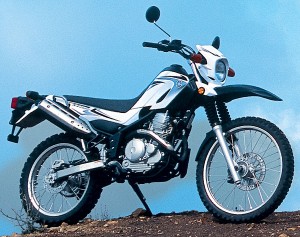
2009 Yamaha XT250
Base price: $4,549
Engine Type: Air-cooled single, SOHC, 2 valves per cyl.
Bore x Stroke: 74.0 x 58.0mm
Displacement: 249cc
Transmission: 5-speed, cable-actuated wet clutch
Final drive: #428 O-ring chain
Wheelbase: 53.5 in.
Rake/Trail: 26.42 degrees/4.17 in.
Seat Height: 31.9 in.
Wet Weight: 289 lbs.
Fuel Capacity: 2.6 gals. (CA 2.4 gals) incl. 0.5-gal. res.
Average mpg: 64.0

